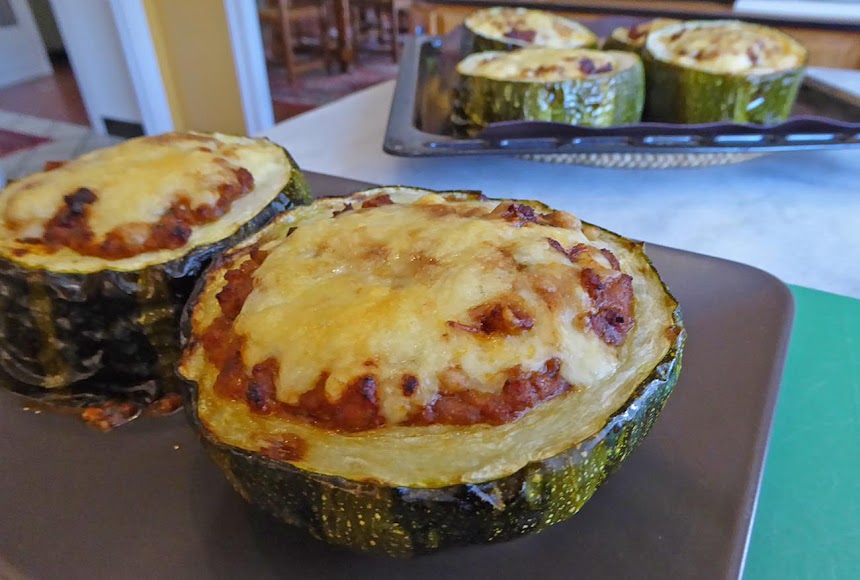The big blow we had yesterday has knocked billions of apples to the ground. I think we'll have some left, and of course we can gather some of the windfall, but not all the apples are ripe. Such are the risks of weather and fruit growing, I guess.
Meanwhile, I made something called « caviar de courgettes » yesterday. It's a dip or spread that you can eat on crackers, chips (crisps), or toast. It's good with olives. It's on the model of « caviar d'aubergines » — what we Americans call "eggplant caviar" — and in fact you might call it "marrow caviar" if you are British.
I'm glad to finally understand what "marrow" or "vegetable marrow" means in the British dialect. I've heard the term for years, but never really understood what it was all about. It turns out that an overgrown zucchini is called a marrow. I looked it up here.
As is often the case, in American English we use an Italian term where the British use a French term. It's true for American "zucchini" versus British "courgette" for example. In French, a courgette or summer squash is just an immature courge, what we call a squash in America. There are summer squash like zucchini and winter squash like acorn, butternut, and pumpkins. The name "squash" derives from a Native American term.
Anyway, a lot of Americans might just throw out the kind of gigantic overgrown summer squashes we sometimes find hiding under the lush foliage of our zucchini plants. They might think they'd be fibrous and tough, but the fact is they are perfectly good prepared correctly. You just have to discard the seeds and pulp in the middle of the "marrow" and cook the firm layer of flesh around the edges.
For the courgette caviar, I cooked another huge summer squash the same way I cooked the one we used to make stuffed squash rings. I cut the squash up, removed the seeds and pulp, and then brushed the pieces with olive or vegetable oil and cooked them in the oven for 30 minutes or so until the flesh was soft and easily pierced with a knife or skewer.
At that point, the leathery green skin peels right off so you can mash or puree the tender squash flesh. I used a food mill to puree it, and it contained very little fiber. I had just over a liter of puree. It freezes well. Actually, I posted a recipe for caviar de courgettes several years ago here.





I love squash, but I usually try for the smaller ones now that I am a empty nester. Ken, I just made butternut squash with browned butter and hazelnuts. Give it a try if you get your hands on a butternut. It is a Yotam Ottolenghi recipe and he is so good with vegetables. I am so happy with the outcome. I could not believe I made that. :)
ReplyDeleteWe have butternut squashes growing in the vegetable garden. Thanks for the idea. There's a similar squash grown here called the sucrine du Berry. I need to find some seeds for that one.
DeleteSucrine du Berry seeds are readily available, Ken...
DeleteI'm sure Pauline will be able to point you in the right direction.
We've grown them in the past, but the flesh is not as tight and firm as a butternut...
and it has a bigger seed pocket, so less flesh...
flavour is great, tho', 'specially when roasted:
Chunks of floury spuds with jackets on....
chunks of squash or courgette, or both, unpeeled...
peeled onions and/or peel shallots...
tomatoes, unpeeled cloves of garlic and chunks of red pepper....
we've used carrots and beetroot in this one, also...
put in bowl and stir around with plenty of olive oil, salt and pepper to taste...
also some fresh herbs...
lovage works extremely well, adds a sort of rich smoky flavour...
sage is also good...
pour into a large baking dish and spread out...
bang in a hot oven until all vegetables are done...
stir around again and serve.
We've also roasted meat directly on the oven rack above the dish...
T
Looks great, and yesterday's hamburger feast/fest looked amaaaaazing.
ReplyDeleteWhen the first picture scrolled up, it looked like a smiley face. Smiling at all that good zucchini
ReplyDeleteLOL
Delete